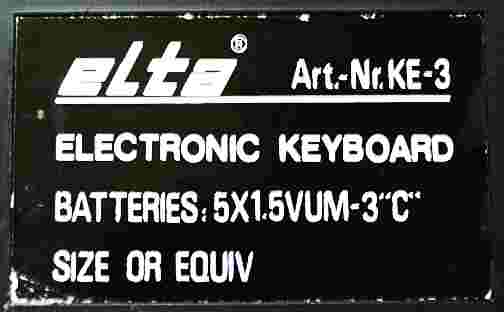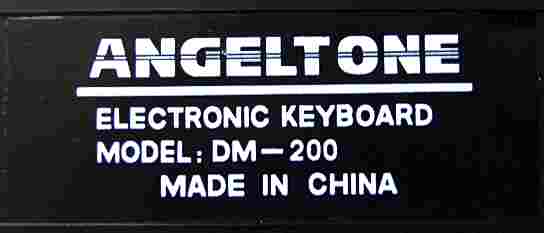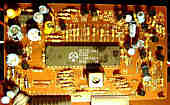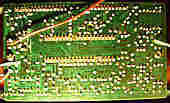Elta
KE-3, Angeltone DM-200 (analogue squarewave keyboard
with accompaniment but no rhythm)
Elta KE-3

This small beginners/ toy keyboard is something really bizarre, because
it has 8 nice accompaniments with even arpeggio, but no rhythm(!). Its
warm squarewave sound and technology resemble very much the Angeltone
DM-380/ Fujitone 3-A. (see there) although
it has less features. It has also 8 nice demo melodies. Unfortunately at
least in unmodified state a keyboard matrix flaw prevents to play certain
notes simultaneously despite it is 2 note polyphonic, and volume is too
loud and can not be set reasonable low.

On the box is still a tag showing that the German initial retail price
was 89DM (about 40€), and the keyboard picture on the box has a crossed
out brand label "ANGELTONE", which apparently was the genuine manufacturer
of this small tablehooter. It was also released as Fujiyama 230
(by "Japan Design"?, seen on eBay).
 |

crossed- out Angeltone logo on the box photo |
main features:
-
37 mini keys
-
2 built-in speakers (mono, but nice quality)
-
main voice polyphony only 2 notes (a keyboard flaw truncates held
notes during fast play, only 1 note with accompaniment)
-
8 OBS preset sounds {piano, oboe, guitar, xylophone, piccolo, mandolin,
organ, harpsichord}
-
8 OBS preset accompaniments {rhumba, march, pops, bossanova, tango, disco,
16 beat, waltz} (mislabelled "rhythm")
-
volume +/- buttons (4 steps, all are way too loud)
-
single finger chord (mislabelled "fingered", only accompaniments, no organ
chord mode)
-
arpeggio button
-
tempo +/- buttons (64 steps?)
-
accompaniment tempo can be set to ridiculous high speeds (>300 BPM?)
-
CPU "Zilog R417, KZ282, LIL8911ASIC, 9406 D6" (40 pin DIL)
-
simple sequencer (monophonic record/ playback with fixed key accompaniment,
no edit)
-
auto power- off
-
8 lovely demo melodies (with accompaniment)

eastereggs:
-
button for different arpeggio addable (button from CPU pin 10 to pin 37)
-
2 additional demo buttons addable (those only change the start tune =>useless)
-
5 lower and 7 higher note keys addable
notes:
This strange instrument seems to be a simplified variant of the Angeltone
DM-380 hardware and has no analogue percussion section anymore to reduce
cost. Like the similar HBATEC it has a
Zilog
brand CPU, but this CPU resembles more the Angeltone one since it
has 40 pins (HBATEC has 28), no organ chord mode and supports a 2nd arpeggio
button. But unlike both, it does not support 16 rhythms nor a fingered
chord mode in the keyboard matrix (although in supports 49 keys). I also
found no separate output pins to connect analogue percussion, thus either
this CPU was never designed to have them, or they are multiplexed with
the key matrix output lines. Unlike the Angeltone DM-380 and
HBATEC,
when
"rhythm" is started, the accompaniment does not stay silent when the "fingered"
button of the "auto bass chord" panel section is not pressed (by the lack
of rhythm otherwise it wouldn't play anything); instead it always plays
a fixed key accompaniment while all keys play the main voice, which also
hints that this CPU was likely never intended to have real rhythm. When
"fingered" is enabled, the left keyboard section is in single finger chord
mode (only accompaniment, no organ chords); after selecting a chord, you
can switch it "off" again to use the full keyboard for melody play together
with that chord, but the arpeggio still works only while "fingered" is
enabled, which looks like a design flaw. Another bug is that with "rhythm"
off and "fingered" enabled, the main voice stays monophonic despite there
is no organ chord mode and thus all keys play only the melody voice.
Despite there is no analogue percussion, the small PCB of the Elta KE-3
still contains a lot of discrete components (analogue envelope controls,
auto power- off etc.). Extremely bizarre is that this PCB (labelled "S2312,
9012 2002" and "TC370 91 2 5") has white component placement
marks printed on its top, but a lot of components are soldered at totally
different places those contradict to the marks (e.g. a transistor is where
a capacitor should go and vice versa etc.). I never saw such a messed up
PCB elsewhere in a consumer product; I can only imagine that this thing
was either a prototype or a new CPU was released that had a changed pinout
and thus the poor factory pieceworkers were urged to solder the discrete
components differently to adapt the given PCB to it (it must be badly confusing
to assemble such PCBs). E.g. there was a shorted solder joint that looked
like a fault, but when cut open, the envelope of the 2nd main voice (or
the arpeggio) plays too short, thus it was likely intended to be shorted
and I had to solder it back.
A design flaw in the keyboard matrix prevented to play any 2 note combinations
those share the same key matrix row. To fix this, solder a diode into each
matrix input line of the keyboard PCB (ribbon cable). The instrument also
plays always quite loud and even at the lowest setting it is still loud
enough to annoy neighbours tonight (although at least the speakers sound
nicely warm and don't distort). To reduce the volume, solder a 10 Ohm resistor
into the loudspeaker line.
Generally the Elta KE-3 sounds much like the Angeltone DM-380/
Fujitone 3-A. (see there); the only
main differences are the digital volume and power buttons (with auto power-
off), the 64 step resolution tempo control (most steps are in the slow
range) and the simple sequencer (monophonic record/ playback with fixed
key accompaniment, no edit). It also features many nice sounding squarewave
demo melodies, those play in an endless sequence but the start melody can
be selected by pressing its corresponding piano key together with the "demo"
button. All demos use a monophonic main voice with only the standard accompaniment
and arpeggio, but they switch them in nice ways. Names were partly identified
by the Angeltone DM-200 manual,
but there they are in a different order and some names seem to be different
(possibly Chinese names of well known melodies).
The demo melodies are:
-
Oh La Paloma Blanca
-
Night in Moscow Suburb
-
Music Box Dancer (here called "The Concert"?)
-
Tea- Picking Melody (a Chinese tune)
-
Edelweis (slow waltz)
-
Wa Haha (a Russian tune?)
-
For Elise (here called "The Youngman"?)
Angeltone DM-200

This is another keyboard based on the same hardware class. Unlike the
Elta
KE-3, it has matrix diodes and thus no polyphony flaw.

different main features:
-
no polyphony flaw
-
only 1 speaker (mine was bent =>distorted horribly)
-
no power off button (only auto power- off)
-
CPU "Zilog R417, KZ282, LIL8911ASIC, 9020 E2" (40 pin DIL)
 |
 |
 panel PCB has empty solder holes
panel PCB has empty solder holes |
 |
 The
golden "ANGELTONE" logo sticker on the case is made of hologram foil. The
main PCB (labelled "S2011") is less messed up and not hacked together;
there are only a few omitted discrete components printed on it. The manual
is a mess of Engrish misspellings, and its German translation is even worse.
The speaker of my (used) specimen was bent and distorted horribly; after
manually aligning the diaphragm it now sounds fairly ok.
The
golden "ANGELTONE" logo sticker on the case is made of hologram foil. The
main PCB (labelled "S2011") is less messed up and not hacked together;
there are only a few omitted discrete components printed on it. The manual
is a mess of Engrish misspellings, and its German translation is even worse.
The speaker of my (used) specimen was bent and distorted horribly; after
manually aligning the diaphragm it now sounds fairly ok.
| removal
of these screws voids warranty... |
|
|
 |

|
|
| |
back
|
|








 panel PCB has empty solder holes
panel PCB has empty solder holes
